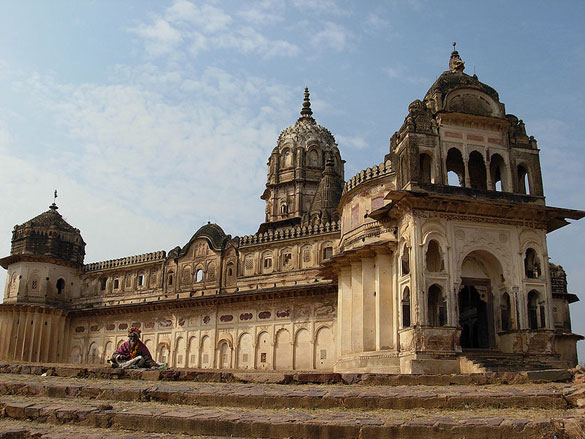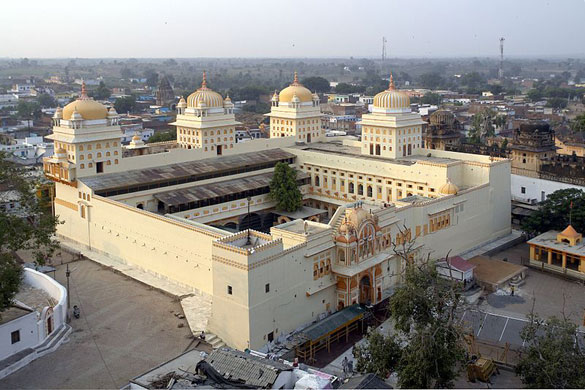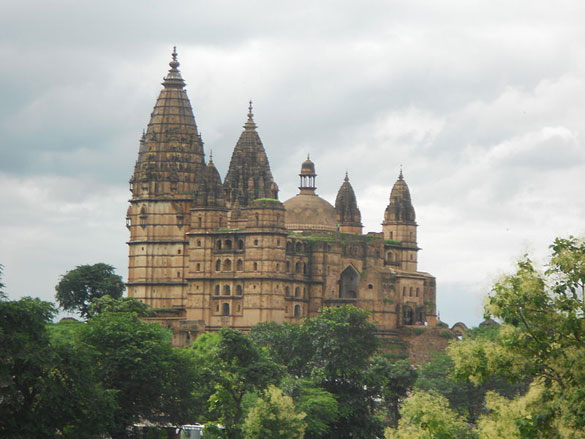There are the baffling remnants of the Bundela days. You can also visit the many chhatris or cenotaphs and shrines situated on the banks of the Betwa River. All the 14 chhatris (memorials to the Orchha rulers) are set together along the Kanchan Ghat of the river. Of the religious structures, mention may be made of the Lakshminarayan Temple, the Raja Ram Temple, the Chaturbhuj Temple, the Hanuman mandirs; the Janaki mandirs; the Siddhi Baba ka Sthan; and the Jugal Kishore Temple.

Lakshminarayan Temple Orchha. Image source wikipedia
The architectural style of the Lakshminarayan Temple is a synthesis of temple and fort moulds. You would also view the most exotic wall paintings representative of the Bundela-Orchha culture in three chambers of the structure. Encompassing a wide fare of secular and spiritual issues, their vivid colors are still vibrantly eloquent. A path made of flagstone connects the temple to the Ram Raja Temple.

Ram Raja Temple Orchha Image source wikipedia
The Ram Raja Temple was constructed on a square-shaped foundation by Madhukar Shah when he ruled Orchha between AD 1554 and AD 1591. He was the predecessor of Maharaja Bir Singh Deo who built the Jahangir Mahal. The nearly plain exterior of the Ram-Raja Temple gets a relief from the set of finely designed domes around the top as well as from the windows that project outwards. A very typical culture is followed here. This is the sole temple in India where Lord Rama – the king of Ayodhya and the protagonist of the most ancient of the two Indian epics, the Ramayana – is prayed as a monarch and that too inside a palace.
Popular legends have it that once the Orchha ruler saw Lord Rama in a vision when the Lord asked the king to build a temple for him. The devout king followed the directions, and had the statue of Lord Rama transferred from its original location in Ayodhya – the birth place of the Lord – to Orchha. But problem arose when the statue arrived as the temple in the Lord’s name was still to be completed. So, King Shah decided to select a spot within the palace and keep the statue there. After some time, the Orchha ruler recollected that Lord Rama had specifically stated in the earlier dream that the statue could not be again shifted from the spot where it would be first installed. Realizing his mistake, King Shah abandoned the plan to complete the temple. Instead he transformed the palace itself into the mandir. Thus, this palace-temple came to be known as the Ram Raja Temple.

Chaturbhuj Temple Orcha. Image source Wikipedia
The Chaturbhuj Temple was built on a wide expanse of stone by Ganesh Bai, Queen of Orchha, during the reign of Mughal Emperor Akbar in the 9th century. This purpose behind the construction of the Chaturbhuj Temple was to preserve there the image of Lord Rama. The image, however, had to kept at the Ram Raja Temple instead. The consecration of the image of Rama at the new location took place during the later part of the 16th century. (Please check the legend behind this shifting in the above section on the Ram Raja Temple.) Fine ornamentation of various symbols embellishes the exterior walls of the temple. These crafted symbols including the lotus emblems have religious significance. A marked aspect of the sanctum sanctorum is the serene senses of sanctity and fervor. Its chastely plain vaulted and high walls further augment the serene aura of the place.
Don’t forget to also visit the two memorials in the Orchha suburbs, namely the Shaheed Smarak and the Hardol’s Smarak. The Shaheed Smarak memorializes one of the greatest martyrs of the Indian freedom struggle – Chandrasekhar Azad. He lived in hiding here, and fought against the British from there during 1926-27. With regards to Hardol Smarak, there is a tragic mysticism about it.
Climb to the roof of the camel shelter called the Uth Khana meant for the Maharaja’s camels to have breathtaking view of the Orchha town below.
Do make it a point to also have a glimpse of the aesthetic sense of the Bundela rulers by taking a stroll and spending some time at the Phool Bagh (flower garden). Spread across a widespread area, its center is characterized by a line of fountains up to the eight-pillar pavilion of the palace. The Orchha rulers utilized the underground cavernous storey as a summer resort to beat the sweltering heat there during those hot months. They devised a novel method to keep it well ventilated. The temperature within the subterranean palace was kept under control with the system of water ventilation. The water was drawn from a bowl-shaped reservoir known as Chandan Katora constructed above the roof of the underground palace. Fountains ideally positioned on the water reservoir sprinkle water and also droplets of water that is filtered and channeled onto the roof surface. This simulated rainfall worked as an air conditioner.